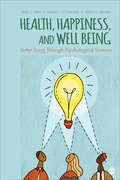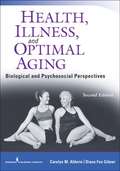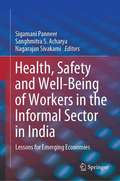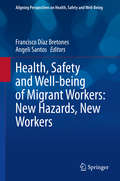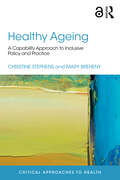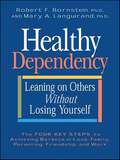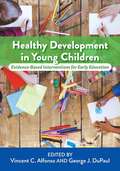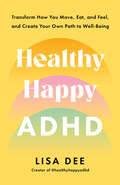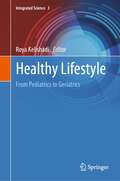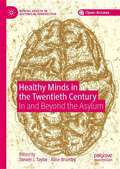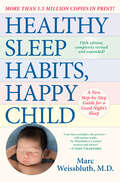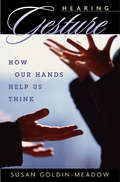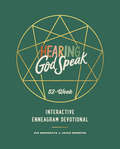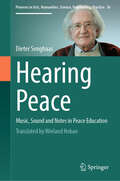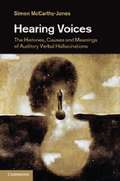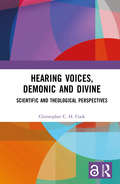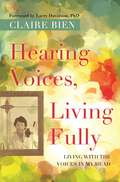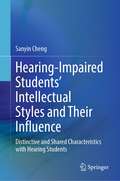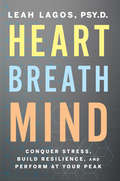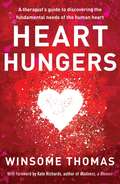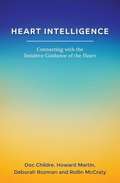- Table View
- List View
Health, Happiness, and Well-Being: Better Living Through Psychological Science
by Dr William O'Donohue Dr Steven Jay Lynn Dr Scott O. LilienfeldHealth, Happiness, and Well-Being by authors Steven Jay Lynn, William T. O’Donohue, and Scott O. Lilienfeld provides the essential tools for becoming a knowledgeable consumer of information on behavioral health. Packed with examples drawn from the media and scientific journals, this volume discusses why accurate, up-to-date, and valid health information is vital to achieving the good life. The book provides readers with a “one stop shop” resource for invaluable information derived from psychological science and conveyed by top experts regarding the optimization of health and psychological well-being. “One of the strongest features is that chapters [are] written by the people who have done the research. I am familiar with the work of all of them, and it’s a stellar group.” —James E. Maddux, George Mason University
Health, Happiness, and Well-Being: Better Living Through Psychological Science
by Dr William O'Donohue Dr Steven Jay Lynn Dr Scott O. LilienfeldHealth, Happiness, and Well-Being by authors Steven Jay Lynn, William T. O’Donohue, and Scott O. Lilienfeld provides the essential tools for becoming a knowledgeable consumer of information on behavioral health. Packed with examples drawn from the media and scientific journals, this volume discusses why accurate, up-to-date, and valid health information is vital to achieving the good life. The book provides readers with a “one stop shop” resource for invaluable information derived from psychological science and conveyed by top experts regarding the optimization of health and psychological well-being. “One of the strongest features is that chapters [are] written by the people who have done the research. I am familiar with the work of all of them, and it’s a stellar group.” —James E. Maddux, George Mason University
Health, Illness, and Optimal Aging
by Carolyn M. Aldwin Diane Fox GilmerThis upper-level undergraduate and graduate text integrates current findings in biology, psychology, and the social sciences to provide comprehensive, multidisciplinary coverage of the aging process. This new edition incorporates the tremendous amount of research that has come to light since the first edition was published. From a physical perspective, the text examines age-related changes and disease-related processes, the demography of the aging population, aging theories, and how to promote optimal aging. Coverage of the psychosocial aspects of aging encompasses mental health, stress and coping, spirituality, and caregiving in later years. The authors address demographic, theoretical, and methodological issues on aging, including a worldwide overview of aging demographics. The book reviews biological and psychosocial theories and offers much-needed information on longitudinal design and statistics as they relate to aging research. It discusses the aging of the major organ systems, the brain and sensory systems, and the endocrine and immune systems; basic anatomy and physiology; normal, impaired, and optimal aging; and functional health. Psychosocial factors that affect health are addressed, including the interplay between physical health and mental health, stress, coping, and social support. The text also covers current issues in social gerontology, including such promising new trends as gerontechnology and Green Houses, and provides information on health promotion programs. New to the Second Edition: Information involving retirement, volunteer opportunities, housing, and adaptation to health changes Coverage of economics and aging, including information on social security and other retirement income and the future of Medicare and Medicaid Significant new information about the regulatory systems.
Health, Safety and Well-Being of Workers in the Informal Sector in India: Lessons for Emerging Economies
by Sanghmitra S. Acharya Sigamani Panneer Nagarajan SivakamiThis book focuses on the core problems of occupational health, safety and well-being of workers in the informal sector in developing countries, where it accounts for most of the rural labour force and a substantial percentage of the urban labour force. The sector is characterised by low incomes, unstable employment and lack of protection in the form of legislation/policies or trade unions. Though some health and problem-solving measures have been introduced, a focused academic effort to address the problems confronting workers in the unorganised sector, or informal economy, is lacking.The book evaluates workers’ physical and mental health in the context of labour migration, social inclusion of minorities and the differently abled, provisions for women workers, demonetisation, occupational safety for hazardous work, and in connection with various areas of informal work, e.g. agriculture, construction, transportation, sanitation, tanning, the tobacco industry, powerloom industry, surrogacy, and self-employment. It provides a well-rounded description of an analytical reflection on the challenges these workers face and focuses on social policy changes to help alleviate them. Accordingly, it offers a valuable asset for researchers and students interested in development studies, the sociology of work, health and labour economics, public health, and social work.
Health, Safety and Well-being of Migrant Workers: New Hazards, New Workers (Aligning Perspectives on Health, Safety and Well-Being)
by Francisco Díaz Bretones Angeli SantosThis volume explores psychosocial problems amongst one of the most vulnerable social groups in our societies, immigrant workers, through a multidisciplinary approach. Migration has sometimes been oversimplified as a flow of workers from “poorer”, developing nations to “wealthier”, industrialised nations. The issue, however, is more complex and currently migration is a global phenomenon in which all countries are recipients of workers from third countries and send workers to third countries. The working conditions of immigrant workers at various levels are not always well known, though some studies have established that the negative impact on migrant workers is cumulative, and primarily stems from adverse living and working conditions in a new country and increased levels of vulnerability. The contributions to this volume cover discussions on migrant workers in the industrial, agricultural and service sectors across the world. They critically study the impact of work Hazards on the health and wellbeing of migrant workers in order to shed light on the social and health implications of migrant work, explore the relation between organizational, psychosocial and work factors, and analyse the migration process from a wider perspective and as a global phenomenon present in every country. The contributors provide multidisciplinary and multicultural contemporary perspectives, thereby providing readers with wide-ranging insights. This volume is of interest to researchers and students from the social and behavioural sciences, particularly those focusing on health studies and migration studies.
Healthy Ageing: A Capability Approach to Inclusive Policy and Practice (Critical Approaches to Health)
by Christine Stephens Mary BrehenyWhat does it mean to age well? This important new book redefines what ‘successful’ ageing means, challenging the idea that physical health is the only criteria to gauge the ageing process and that an ageing population is necessarily a burden upon society. Using Sen’s Capability Approach as a theoretical starting point Healthy Ageing: A Capability Approach to Inclusive Policy and Practice outlines a nuanced perspective that transcends the purely biomedical view, recognising ideas of resilience, as well as the experiences of older people themselves in determining what it means to age well. It builds to provide a comprehensive response to the overarching discourse that successful ageing is simply about eating well and exercising, acknowledging not only that older people are not always able to follow such advice, but also that well-being is mediated by factors beyond the physical. In an era where ageing has become such an important topic for policy makers, this is a robust and timely response that examines what it means to live well as an older person. It will be hugely valuable not only for students of gerontology and social care, but also professionals working in the field.
Healthy Conflict, Peaceful Life: A Biblical Guide for Communicating Thoughts, Feelings, and Opinions with Grace, Truth, and Zero Regret
by Donna JonesAuthor, speaker, and pastor's wife Donna Jones gives women a practical, biblical blueprint for making regret-free choices in the middle of real-life conflict so they can exchange relational turmoil for personal and relational peace.We've all had moments where we look back on a conflict, shake our heads, and think, why did I handle it that way?With three decades of ministry experience, Donna Jones has had a front-row seat to--and been in the middle of--all kinds of conflict and she understands the regret, guilt, heartache, and hurt conflict can produce. But she also knows it's possible for God to use those chaotic, painful moments and turn them into opportunities for better connection with those around us. With encouragement, warmth, and wisdom, Donna shows readers how to navigate the stressful confusion conflict can bring and helps them todiscover the single most important quality necessary to handle conflict well;communicate thoughts, feelings, and opinions with grace, truth, and zero regret;be equipped to handle conflict in a God honoring way by exchanging conflict styles that hurt with conflict styles that heal; identify common conflict mistakes and prevent unnecessary disagreements and defeat; andstop being pulled into other people's drama and remain calm in the midst of chaos. Whether readers are dealing with daily disagreements or occasional blowups, Healthy Conflict, Peaceful Life offers them a new paradigm, one where they learn how to honor God when they've been hurt, communicate when they'd rather retaliate, and move toward others when it seems easier to run away.
Healthy Dependency: Leaning on Others without Losing Yourself
by Mary A. Languirand Robert F. BornsteinFrom the psychologist who coined the phrase "healthy dependency"—the first and only book that outlines its four key steps and helps readers understand and use these principles to achieve balance in love, in friendships, with family, and at work.The research is clear: Too much dependency in our relationships can be a bad thing, but too little dependency is just as bad. Healthy dependency—that flexible middle ground between rigid independence and unhealthy overdependence—is the ability to balance intimacy and autonomy, lean on others while maintaining a strong sense of self, and feel good (not guilty) about asking for help when you need it.The authors' studies confirm that healthy dependency brings a wealth of positive effects including: increased satisfaction in love relationshipsgreater likelihood of academic and career successbetter family communication and improved parenting skillsenhanced physical and psychological healthThis unique book, meticulously organized and laced throughout with case studies, anecdotes, relationship-style questionnaires, and research findings, draws from the authors' more than 20 years of research and clinical experience. A valuable guide to achieving healthy relationships between men and women of all ages, it will help readers identify where they are on the relationship continuum, and understand the skills they will need to address in order to strengthen their personal, professional, and family relationships.
Healthy Development in Young Children: Evidence-Based Interventions for Early Education
by Vincent C. Alfonso George DuPaulThis book shows experienced educators and mental health practitioners who work with young children (2‑5 years of age) how to implement programs and interventions based on the latest scientific research in day care centers, preschools, special education settings, and kindergartens. Every year brings new research studies that aim to describe early childhood development. Despite this boom in research, there has been little useful translation of these studies into clear recommendations for educators and mental health practitioners. <p.<p>Chapters in this volume offer guidelines on child assessment across five key areas of development—cognitive, language, behavioral and social-emotional functioning, adaptive behavior, and motor skills. Contributors describe interventions to help children meet age‑appropriate expectations regarding cognitive and emotional maturity, and other key developmental tasks including numerical understanding, early literacy programs; and play. Other chapters discuss broad policies and legal issues impacting early education. Special attention is given to interventions for preschoolers with developmental disabilities, and the unique needs of children who are culturally and linguistically diverse.
Healthy Happy ADHD: Transform How You Move, Eat, and Feel, and Create Your Own Path to Well-Being
by Lisa DeeA health coach with ADHD offers the ultimate wellness guide for neurodivergent women, full of easy-to-implement and adaptable advice to help you thriveADHD makes it hard to maintain a healthy lifestyle, but an unhealthy lifestyle can make ADHD more difficult to live with. Health and fitness coach Lisa Dee experienced this problem firsthand when the executive dysfunction, exhaustion, and burnout from undiagnosed ADHD wreaked havoc on her physical, mental, and emotional well-being.After receiving a diagnosis at age thirty-one, Dee realized that she needed to consider how her ADHD brain and body operated if she wanted to feel her best. In Healthy Happy ADHD, she shares the mindset shifts and strategies that form her foundation for healthy living and helped alleviate her ADHD challenges. Drawing from her lived experience and research, she shows you how to revamp your routines, build new habits, and bring ease to your busy brain by learning to● ditch the restrictive rules and shame-based ideas about what exercise, healthy eating, and resting &“should&” look like● eat well with ADHD Easy Meals and understand how food affects your energy, mood, and brain health● prepare for the impacts of hormonal fluctuations and health conditions such as PMDD on your ADHD symptoms● reconnect with yourself and practice self-compassion through reflection and mindfulness exercisesWith practical advice tailored for women and presented in an ADHD-friendly format, this book empowers you to create a lifestyle that works with your ADHD.
Healthy Lifestyle: From Pediatrics to Geriatrics (Integrated Science #3)
by Roya KelishadiThis book offers a comprehensive overview on lifestyle habits related to development of risk factors of chronic diseases. It provides a summary of the impacts of various modifiable factors that influence long-term health status. The accumulation of unhealthy lifestyle habits shows that over the life course, increasing the number, duration, and severity of unhealthy behaviors would increase the risk of disease development. This contributed volume highlights the fact that establishing a healthy lifestyle is easier and more effective than focusing on lifestyle change
Healthy Minds in the Twentieth Century: In and Beyond the Asylum (Mental Health in Historical Perspective)
by Steven J. Taylor Alice BrumbyThis open access edited collection contributes a new dimension to the study of mental health and psychiatry in the twentieth century. It takes the present literature beyond the ‘asylum and after’ paradigm to explore the multitude of spaces that have been permeated by concerns about mental well-being and illness. The chapters in this volume consciously attempt to break down institutional walls and consider mental health through the lenses of institutions, policy, nomenclature, art, lived experience, and popular culture. The book adopts an international scope covering the historical experiences of Britain, Ireland, and North America. In accordance with this broad approach, contributions to the volume span academic fields such as history, arts, literary studies, sociology, and psychology, mirroring the diversity of the subject matter. This book is available open access under a CC BY 4.0 license at link.springer.com
Healthy Sleep Habits, Happy Child, 5th Edition: A New Step-by-Step Guide for a Good Night's Sleep
by Marc WeissbluthThe perennial favorite for parents who want to get their kids to sleep with ease—now in its fifth edition, fully revised and updated, with a new step-by-step guide for a good night&’s sleep.With more than 1.5 million copies in print, Dr. Marc Weissbluth&’s step-by-step regimen for instituting beneficial habits within the framework of your child&’s natural sleep cycles has long been the standard-setter in baby sleep books. Now with a new introduction and quick-start guide to getting your child to sleep, Healthy Sleep Habits, Happy Child has been totally rewritten and reorganized to give tired parents the information they need quickly and succinctly. This new edition also includes the very latest research on the importance of• implementing bedtime routines• practicing parental presence at bedtime• recognizing drowsy signs• the role of the father as an active partner in helping the child sleep better• overcoming challenges families face to help their child sleep better• different cultural sleep habits from around the world• individualized and nonjudgmental approaches to sleep trainingSleep is vital to your child&’s health, growth, and development. The fifth edition of Healthy Sleep Habits, Happy Child gives parents proven strategies to ensure healthy, high-quality sleep for children at every age.
Hearing Eye II: The Psychology Of Speechreading And Auditory-Visual Speech
by Ruth CampbellThis volume outlines some of the developments in practical and theoretical research into speechreading lipreading that have taken place since the publication of the original "Hearing by Eye". It comprises 15 chapters by international researchers in psychology, psycholinguistics, experimental and clinical speech science, and computer engineering. It answers theoretical questions what are the mechanisms by which heard and seen speech combine? and practical ones what makes a good speechreader? Can machines be programmed to recognize seen and seen-and-heard speech?. The book is written in a non-technical way and starts to articulate a behaviourally-based but cross-disciplinary programme of research in understanding how natural language can be delivered by different modalities.
Hearing (Our) Voices
by Barbara SchneiderHearing (Our) Voices describes two innovative participatory action research projects - one on communication with medical professionals, the other on housing - carried out by a group of people diagnosed with schizophrenia under the guidance of Professor Barbara Schneider. Participants designed the research, conducted interviews and focus groups, participated in data analysis, and disseminated research results through a number of innovative strategies including theatre performances, a documentary film, a graphic novel, and a travelling exhibit.Emerging from these projects is the central and significant finding that people diagnosed with schizophrenia are caught between their dependence on care and their longing for independent lives. The research presented in Hearing (Our) Voices points to a way to resolve this paradox and transform lives through the inclusion of people diagnosed with schizophrenia in research, in decision-making about their own treatment and housing, and in public discourse about schizophrenia.
Hearing Gesture: How Our Hands Help Us Think
by Susan Goldin-MeadowMany nonverbal behaviors—smiling, blushing, shrugging—reveal our emotions. One nonverbal behavior, gesturing, exposes our thoughts. This book explores how we move our hands when we talk, and what it means when we do so. Susan Goldin-Meadow begins with an intriguing discovery: when explaining their answer to a task, children sometimes communicate different ideas with their hand gestures than with their spoken words. Moreover, children whose gestures do not match their speech are particularly likely to benefit from instruction in that task. Not only do gestures provide insight into the unspoken thoughts of children (one of Goldin-Meadow’s central claims), but gestures reveal a child’s readiness to learn, and even suggest which teaching strategies might be most beneficial. In addition, Goldin-Meadow characterizes gesture when it fulfills the entire function of language (as in the case of Sign Languages of the Deaf), when it is reshaped to suit different cultures (American and Chinese), and even when it occurs in children who are blind from birth. Focusing on what we can discover about speakers—adults and children alike—by watching their hands, this book discloses the active role that gesture plays in conversation and, more fundamentally, in thinking. In general, we are unaware of gesture, which occurs as an undercurrent alongside an acknowledged verbal exchange. In this book, Susan Goldin-Meadow makes clear why we must not ignore the background conversation.
Hearing God Speak: A 52-Week Interactive Enneagram Devotional
by Eve Annunziato Jackie BrewsterCombining the Enneagram system with biblical truth, this interactive, yearlong devotional helps you better understand yourself and other people while guiding you toward a deeper relationship with Christ.This weekly, interactive guide helps you explore how your heavenly Father is speaking to you as you listen to Him in your Enneagram language. Learn to identify patterns of behavior that drive your decisions and uncover your deepest thoughts, unconscious motivations, and personality traits. Hearing God Speak addresses each Enneagram type with weekly disciplines, meditations, interactive responses, and contemplations. Once you understand how you are wired, you can engage with God and His Word in a fresh way, bringing you profound knowledge of His truth. Features include: • beautifully designed, full-color pages • multiple interactive elements each week • seven weekly actions and prompts for meditation, prayer, reflection, response, and gratitude • a lesson and action step for each Enneagram typeHearing God Speak is a mentor and friend in book form. No matter your Enneagram number, this devotional experience is about learning to hear God as He communicates directly and uniquely to you.
Hearing Peace: Music, Sound and Notes in Peace Education (Pioneers in Arts, Humanities, Science, Engineering, Practice #36)
by Dieter SenghaasListening to peace. When social scientists, publicists and teachers approach the problem of peace, they pay special attention to the causes of violence and war. Recently, however, insights into the causes of peace have gained broad resonance. The question is which factors, individually and in their interaction, are sustainably conducive to peace. Aesthetic dimensions of a peace order, however, usually remain underexposed, although the problem of peace can be impressively conveyed through images of peace. The fact that the essays in this book explain that access to various dimensions of peace through musical and compositional contributions can also be illuminating: Which peace-relevant problems have composers addressed in their works? Striking examples are explained. They are all to be found in the offerings of classical, i.e. value-retaining music of the past five centuries. - A unique book on peace education - For teachers and students in peace research and in music studies - Written by one of the co-founders of peace research in Germany - A key background book for peace concerts - A musical appeal for peace
Hearing Voices
by Simon Mccarthy-Jones"The meanings and causes of hearing voices that others cannot hear (auditory verbal hallucinations, in psychiatric parlance) have been debated for thousands of years. Voice-hearing has been both revered and condemned, understood as a symptom of disease as well as a source of otherworldly communication. Those hearing voices have been viewed as mystics, potential psychiatric patients or simply just people with unusual experiences, and have been beatified, esteemed or accepted, as well as drugged, burnt or gassed. This book travels from voice-hearing in the ancient world through to contemporary experience, examining how power, politics, gender, medicine and religion have shaped the meaning of hearing voices. Who hears voices today, what these voices are like and their potential impact are comprehensively examined. Cutting edge neuroscience is integrated with current psychological theories to consider what may cause voices and the future of research in voice-hearing is explored"--Provided by publisher.
Hearing Voices, Demonic and Divine: Scientific and Theological Perspectives
by Christopher C. CookThe Open Access version of this book, available at www.taylorfrancis.com/books/9781472453983, has been made available under a Creative Commons Attribution-Non Commercial-No Derivative 4.0 license. Experiences of hearing the voice of God (or angels, demons, or other spiritual beings) have generally been understood either as religious experiences or else as a feature of mental illness. Some critics of traditional religious faith have dismissed the visions and voices attributed to biblical characters and saints as evidence of mental disorder. However, it is now known that many ordinary people, with no other evidence of mental disorder, also hear voices and that these voices not infrequently include spiritual or religious content. Psychological and interdisciplinary research has shed a revealing light on these experiences in recent years, so that we now know much more about the phenomenon of "hearing voices" than ever before. The present work considers biblical, historical, and scientific accounts of spiritual and mystical experiences of voice hearing in the Christian tradition in order to explore how some voices may be understood theologically as revelatory. It is proposed that in the incarnation, Christian faith finds both an understanding of what it is to be fully human (a theological anthropology), and God’s perfect self-disclosure (revelation). Within such an understanding, revelatory voices represent a key point of interpersonal encounter between human beings and God.
Hearing Voices, Living Fully: Living with the Voices in My Head
by Larry Davidson Claire BienWhen Claire Bien first began hearing voices, they were infrequent, benign and seemingly just curious about her life and the world around her. But the more attention Claire paid, the more frequently they began to speak, and the darker their intentions became... Despite escalating paranoia, an initial diagnosis of Schizophreniform Disorder and taking medication with debilitating side effects, Claire learned to face her demons and manage her condition without the need for long-term medication. In this gripping memoir, Claire recounts with eloquence her most troubled times. She explains how she managed to regain control over her mind and her life even while intermittently hearing voices, through self-guided and professional therapy and with the support of family and friends. Challenging a purely medical understanding of hearing voices, Claire advocates for an end to the stigma of those who experience auditory verbal hallucinations, and a change of thinking from the professionals who treat the condition.
Hearing-Impaired Students’ Intellectual Styles and Their Influence: Distinctive and Shared Characteristics with Hearing Students
by Sanyin ChengThis book is the first on the implications of intellectual styles for higher education of students with hearing impairment. It provides a systematic delineation for intellectual styles of students with hearing impairment in comparison with students without hearing impairment. It takes an initial step to present the analysis concerning the mediating role of intellectual styles in the relationships between personal factors and student developmental outcomes.
Heart Breath Mind: Train Your Heart to Conquer Stress and Achieve Success
by Dr. Leah LagosStress is not in your head, it&’s in your body—this is the key to peak performance that Leah Lagos, PsyD, BCB, an internationally known expert in biofeedback and sport and performance psychology, wants us to know. In this book, she shares with readers for the first time the same program that she uses with top athletes, CEOs, business leaders—anyone who wants and needs to perform at their best. What makes her scientifically proven 10-week program unlike any other is that she recognizes the link between heart rhythms and stress to create specific, clinically tested exercises and breathing techniques that allow you to control your body&’s physical response to stress. She pairs this training with cognitive-behavioral exercises to offer a two-tiered process for strengthening health and performance, enabling readers to respond more flexibly to stressful situations, let go of negative thoughts and emotions, and ultimately be more focused and confident under pressure.
Heart Hungers
by Winsome ThomasWithin us all is the potential to lead a fulfilled and satisfied life. But how to achieve this, or even where to start, is the hard part. Leading psychologist Winsome Thomas believes that to achieve true happiness eight fundamental human desires need to be met. They are called heart hungers: basic needs that stem from security, service, esteem, enjoyment, love, limits, freedom and spirituality. When one or more heart hunger isn't fulfilled, especially over a long period of time, we experience anxiety, despair or depression. Using remarkable true stories from the people she has treated, most notably the author of Madness: A Memoir, Kate Richards, Heart Hungers will help you uncover your own heart hungers, and inspire the confidence to fulfill them. Deeply poignant, honest and inspiring, Winsome weaves her own tale of heart hunger discovery throughout the book, supporting the belief that the therapist's own lived experience is a vital component to each individual's journey of discovery and recovery.
Heart Intelligence
by Doc Childre Howard Martin Deborah Rozman Rollin MccratyHeart Intelligence provides readers with a new, high definition picture of the energetic heart as a unifying, creative, intuitive intelligence that we can learn to draw on for moment to moment guidance. Heart Intelligence links the physical heart to the spiritual (energetic) heart. Through its extensive communication with the brain and body, the heart is intimately involved in how we think, feel, and respond to the world. Expanding on their breakthrough book, The HeartMath Solution, the authors offer heart-based techniques and guidelines for living from the heart, which connects the puzzle pieces of our purpose and fulfillment. The book provides information and simple practices for accessing our heart's intuitive guidance to connect with our highest choices for better outcomes. Our choices are especially important through these changing times because they constantly create or disrupt our peace, happiness and self-security. Our thoughts and feelings influence the chemistry that regulates much of our health - how we feel, for better or worse. Our thoughts, feelings, emotions and attitudes are just frequencies that we can learn to change - once we put our heart into our intention. Heart Intelligence provides practices to replace fear with the attitude of intelligent concern (managed concern) which leaves us in charge and more attuned to intuitive direction. We learn the benefits of practicing simple coherence techniques a few times a day for boosting resilience and emotional balance; making appropriate choices; and clearing our mind from anxiety or overwhelm when needed. It is through deepening our heart intelligence, coherence and connection that humanity will be able to shift from separation to cooperation resulting in higher solutions to our personal and global problems.
